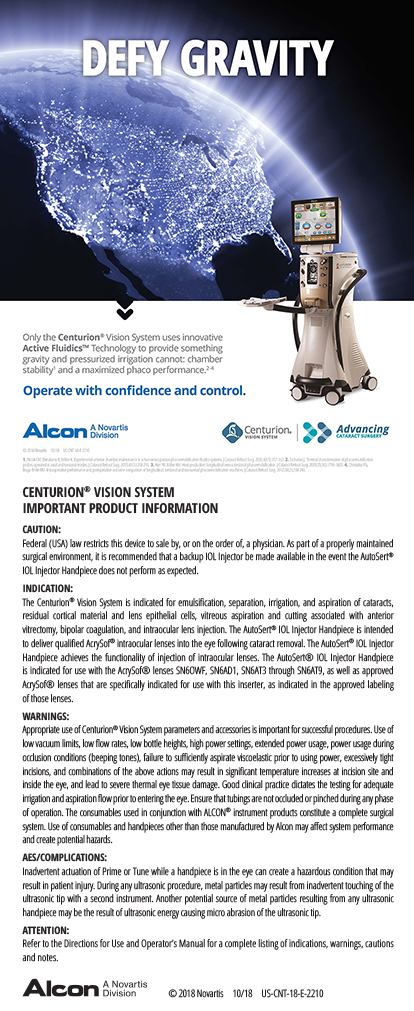Optometrists and ophthalmologists collaborate every day to deliver full-scope integrated eye care to all patients, including those needing cataract surgery. Optometrists provide the majority of primary and medical eye care and rely on their ophthalmology colleagues to consult on medical and surgical care that falls outside of their comfort zone or scope of practice.
Ideally Speaking
Generally, cataract surgery referrals between optometrists and ophthalmologists should occur via a seamless patient experience, whether occurring in the same integrated practice or between providers in separate locations. Optometrists should feel comfortable and confident that, when they send a patient to an ophthalmologist for a consultation, that patient will have a smooth transition to their colleague’s office and receive the highest quality medical and surgical care possible. Conversely, the physician receiving the optometric referral should essentially view him or herself as an extension of the care the patient received from the optometrist. Whether asking for a second opinion or referring a patient for cataract surgery care, a smooth and coherent working relationship will result in a high-quality and positive patient experience.
Without question, the basis for maintaining a strong and efficient referral relationship is consistent two-way communication. Systems and processes must be established between the offices of each doctor in order to seamlessly share patients. Referring doctors need to feel comfortable with their access to specialty care, and specialists should feel comfortable referring patients back for ongoing monitoring and collaborative care. There is no substitute for a one-on-one meeting between referring and consulting doctors to initially cultivate and then maintain an ongoing comanaging relationship. Subsequent meetings offer a great opportunity for both parties to check in and keep the lines of communication open so that patients can continue to be successfully comanaged.

Anatomy of a Communication Breakdown
There will be incidents when difficulties arise in coordinating care between practitioners. Most breakdowns will occur in one of two areas: office-to-office communication or doctor-to-doctor communication. The basic exchange of information between the offices of referring and consulting doctors can easily snowball into issues that require intervention.
Scenario No. 1: Office-to-Office
If an OD hands a patient a consultant doctor’s business card and tells the patient to make an appointment for cataract surgery, but he or she never makes the call, a communication gap can easily develop. Although the consulting surgeon never sees the patient, the referring clinician never receives a consultation report and may feel cut out of the loop. Also as a result, the cataract surgeon may perceive a reduction in referrals from that particular OD. This communication breakdown can easily occur simply because a patient didn’t follow up on the OD’s recommendation. Depending on the relationship between offices, these types of situations can be averted by establishing a protocol for scheduling patients between offices.
Several options for keeping tabs on patients may be implemented, including having a referring optometrist’s practice call the consulting cataract surgeon’s practice while the patient is in the office to assist in making the appointment. Additionally, to ensure that patients aren’t inadvertently lost, the consulting surgeon may use the referring optometrist’s office fax, secure email, or communicate directly through a website portal.
Scenario No. 2: Doctor-to-Doctor
The second most common type of breakdown can occur with regard to doctor-to-doctor communication, where the most seemingly elementary problem can potentially escalate into major difficulties between offices. Specifically, when a patient is initially referred, it is helpful for the consulting physician to have access to the optometrist’s chart notes and any previous testing because he or she is typically meet- ing the patient for the first time. Any clinical information that accompanies the consultation request can help the consultant better prepare for the initial patient examination and will therefore create a more comfortable environment for the patient.
Conversely, it is imperative that referring clinicians receive patients’ consultation reports, treatment plans, or other progress notes from the consulting physician. If a referring optometrist feels excluded from the process, communication can easily break down. Furthermore, a referring doctor’s access to a consultant must be maintained at all times. He or she should be able to quickly and easily contact the specialist both during and after office hours.
During regular office hours, the optometrist should feel confident that he or she could reach the consulting colleague (or an office representative) for an urgent referral or even for a chairside consultation. Likewise, the optometrist should feel comfortable that he or she can easily find backup if assistance with patient care is needed during weekend or evening hours. Either way, a mechanism should be in place to ensure access and availability of the consulting physician to the referring doctor. This relationship is the foundation of the operational success that places the patient’s needs above all else when care is comanaged between offices.
Preparation May Ensure Success
Many of the strategies we have described are quite simple to implement individually. A compromise in any step of the protocol, however, can undoubtedly cause a complete system failure, resulting in a breakdown of communication between the doctors’ practices and a potential compromise in optimal patient care.







